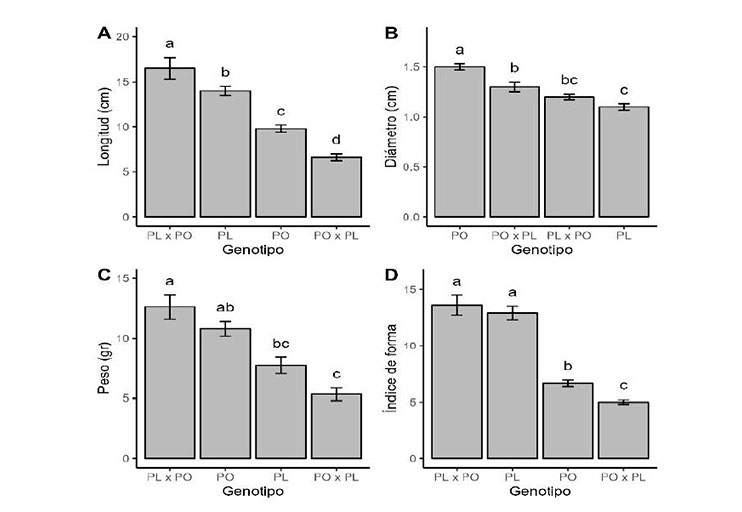Presencia de metaxenia en frutos de 40 días pospolinzación en Vanilla planifolia Andrews y V. pompona Schiede
DOI:
https://doi.org/10.29312/remexca.v14i2.2973Palabras clave:
Vanilla planifolia, Vanilla pompona, cultivoResumen
El fruto de vainilla (Vanilla planifolia Andrews) genera una importante derrama económica; sin embargo, los frutos mejor pagados son aquellos de mayor longitud (tipo gourmet), por lo cual se necesitan estrategias que permitan obtener frutos de ese tipo. Ante ello, una opción es la inducción de metaxenia, entendida como el aumento de tamaño de los frutos a causa de la polinización con polen extranjero. Para el caso de la vainilla, se podría utilizar polen de V. pompona Schiede, ya que suele ser una especie acompañante y su fenología coincide con la de V. planifolia. Se realizaron polinizaciones cruzadas entre V. planifolia y V. pompona durante abril de 2021, se evaluó la longitud total, el diámetro, el peso y el índice de forma 40 días después. Se encontró influencia del polen extranjero, manifestada en frutos más largos y pesados si la flor de V. planifolia era polinizada con polen de V. pompona, mientras que si el polen extranjero era de V. planifolia en flores de V. pompona los frutos fueron más pequeños y livianos. La polinización cruzada entre V. planifolia con polen de V. pompona es una alternativa para los productores para que obtengan frutos de tipo gourmet con mayor facilidad.
Descargas
Citas
Barrera-Rodríguez, A.; Herrera-Cabrera, B.; Jaramillo-Villanueva, J.; Escobedo-Garrido, S. y Bustamante-González, A. 2009. Caracterización de los sistemas de producción de vainilla (Vanilla planifolia A.) bajo naranjo y en malla sombra en el totonacapan. Trop. Subtrop. Agroecosyst. 10(2):199-212. https://www.redalyc.org/articulo.oa?id=93912989008.
Bodor, P.; Gaal, M. and Toth, M. 2008. Metaxenia in apples cv. Rewena, Relinda, Baujade as influenced by scab resistant pollinizers. Int. J. Hort. Sci. 14(3):11-14. https://doi.org/10.31421/IJHS/14/3/795.
Ehlenfeldt, M. K. 2003. Investigations of metaxenia in northern highbush blueberry (Vaccinium corymbosum L.) cultivars. J. Amer. Pomological Soc. 57(1):26-31.
Hernández-Hernández, J. and Lubinsky, P. L. 2011. Cultivation systems. In: Odoux, E. and Grisoni, M. Ed. Vanilla. Taylor and Francis group. USA. 75-96 pp.
Lubinsky, P. L.; Cameron, K. M.; Molina, M. C.; Wong, M.; Lepers, A. S.; Gómez, P. A. and Seung, C. K. 2008. Neotropical roots of a Polynesian spice: the hybrid origin of Tahitian vanilla, vanilla tahitensis (Orchidaceae). Amer. J. Bot. 95(8):1040-1047. https://doi.org/10.3732/ajb.0800067.
Menchaca-García, R. A. 2018. In vitro propagation of vanilla. In: Havkin-Frenkel, D. And Belanger, F. C. Ed. Handbook of vanilla science and technology. Segunda edition. Wiley Blackwell. Estados Unidos. 181-190 pp.
Militaru, M.; Butac, M.; Sumedrea, D. and Chitu, E. 2015. Effect of metaxenia on the fruit quality of scab resistant apple varieties. Agr. Agric. Sci. Proc. 6:151-156. https://doi.org/10.1016/ j.aaspro.2015.08.052.
Mizrahu, Y.; Mouyal, J.; Nerd, A. and Sitrit, Y. 2004. Metaxenia in the vine cacti Hylocereus polyrhizus and Selenicereus spp. Annals Bot. 93(4):469-472. https://doi.org/10.1093/ aob/mch055.
Olfati, J. A.; Sheykhtaher, Z.; Qamgosar, R.; Khasmakhi, S. A.; Peyvast, G. H.; Samizadeh, H. and Rabiee, B. 2014. Xenia and metaxenia on cucumber fruit and seed characteristics. Int. J. Veg. Sci. 16(3):243-252. https://doi.org/10.1080/19315260903584167.
R Core Team. 2020. R: a language and environment for statistical computing. https://www.R-project.org/.
Ranadive, A. S. 2018. Quality control of vanilla beans and extracts. In: Havkin-Frenkel, D. and Belanger, F. C. Ed. handbook of vanilla science and technology. Segunda edición. Wiley Blackwell. Estados Unidos. 239-260 pp.
Sabir, A. 2014. Xenia and Metaxenia in grapes: differences in berry and seed characteristics of maternal grape cv. ‘Narince’ (Vitis vinifera L.) as influenced by different pollen sources. Plant biol. 17:567-573. https://doi.org/10.1111/plb.12266.
Sarma, Y. R.; Thomas, J.; Sasikumar, B. and Varadarasan, S. 2011. Vanilla production in india. In: Odoux, E. y Grisoni, M. Ed. Vanilla. Taylor and Francis group. Estados Unidos. 295-326 pp.
Sasikumar, B. 2010. Vanilla breeding-a review. Agr. Revs. 31(2):139 -144.
Swingle, W. T. 1928. Metaxenia in date palm, possibly a hormone action by the embryo or the endosperm. J. Hered. 19(6):257-268. https://doi.org/10.1093/oxfordjournals.jhered.a102996.
Teoh, E. S. 2019. Orchids as aphrodisiac, medicine or food. Springer. Singapur. 109-130 pp.

Descargas
Publicado
Cómo citar
Número
Sección
Licencia
Derechos de autor 2023 Revista Mexicana de Ciencias Agrícolas

Esta obra está bajo una licencia internacional Creative Commons Atribución-NoComercial 4.0.
Los autores(as) que publiquen en Revista Mexicana de Ciencias Agrícolas aceptan las siguientes condiciones:
De acuerdo con la legislación de derechos de autor, Revista Mexicana de Ciencias Agrícolas reconoce y respeta el derecho moral de los autores(as), así como la titularidad del derecho patrimonial, el cual será cedido a la revista para su difusión en acceso abierto.
Los autores(as) deben de pagar una cuota por recepción de artículos antes de pasar por dictamen editorial. En caso de que la colaboración sea aceptada, el autor debe de parar la traducción de su texto al inglés.
Todos los textos publicados por Revista Mexicana de Ciencias Agrícolas -sin excepción- se distribuyen amparados bajo la licencia Creative Commons 4.0 atribución-no comercial (CC BY-NC 4.0 internacional), que permite a terceros utilizar lo publicado siempre que mencionen la autoría del trabajo y a la primera publicación en esta revista.
Los autores/as pueden realizar otros acuerdos contractuales independientes y adicionales para la distribución no exclusiva de la versión del artículo publicado en Revista Mexicana de Ciencias Agrícolas (por ejemplo incluirlo en un repositorio institucional o darlo a conocer en otros medios en papel o electrónicos) siempre que indique clara y explícitamente que el trabajo se publicó por primera vez en Revista Mexicana de Ciencias Agrícolas.
Para todo lo anterior, los autores(as) deben remitir el formato de carta-cesión de la propiedad de los derechos de la primera publicación debidamente requisitado y firmado por los autores(as). Este formato debe ser remitido en archivo PDF al correo: revista_atm@yahoo.com.mx; revistaagricola@inifap.gob.mx.
Esta obra está bajo una licencia de Creative Commons Reconocimiento-No Comercial 4.0 Internacional.


